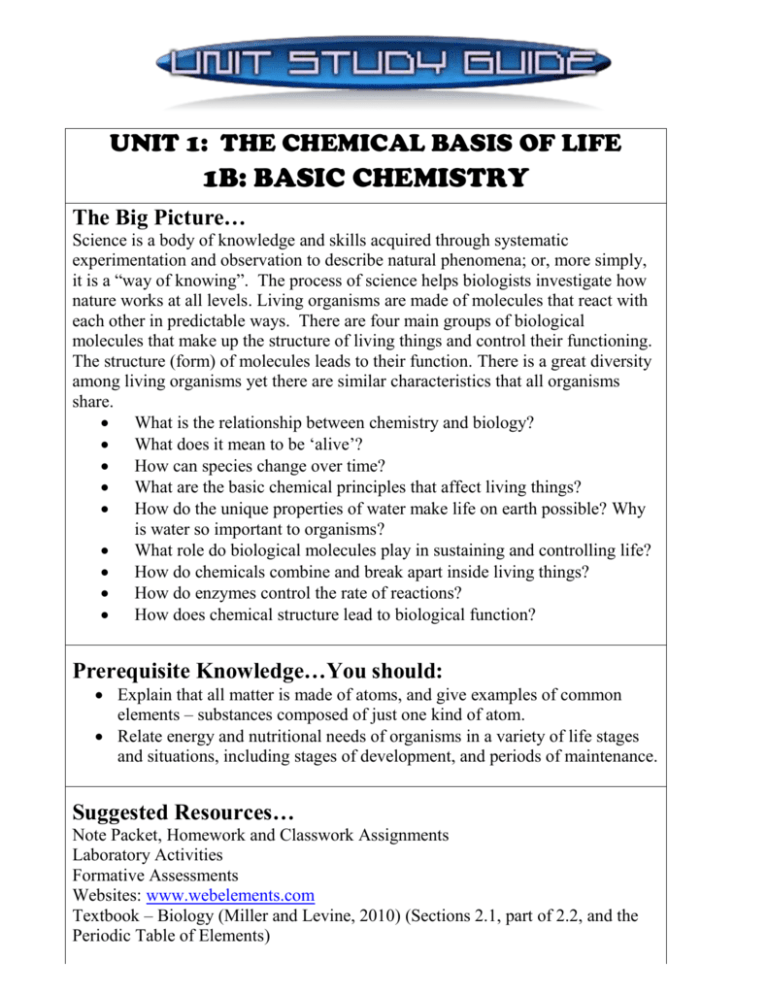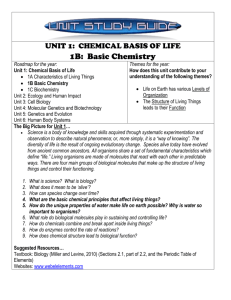Basic Chemistry USG
advertisement

UNIT 1: THE CHEMICAL BASIS OF LIFE 1B: BASIC CHEMISTRY The Big Picture… Science is a body of knowledge and skills acquired through systematic experimentation and observation to describe natural phenomena; or, more simply, it is a “way of knowing”. The process of science helps biologists investigate how nature works at all levels. Living organisms are made of molecules that react with each other in predictable ways. There are four main groups of biological molecules that make up the structure of living things and control their functioning. The structure (form) of molecules leads to their function. There is a great diversity among living organisms yet there are similar characteristics that all organisms share. What is the relationship between chemistry and biology? What does it mean to be ‘alive’? How can species change over time? What are the basic chemical principles that affect living things? How do the unique properties of water make life on earth possible? Why is water so important to organisms? What role do biological molecules play in sustaining and controlling life? How do chemicals combine and break apart inside living things? How do enzymes control the rate of reactions? How does chemical structure lead to biological function? Prerequisite Knowledge…You should: Explain that all matter is made of atoms, and give examples of common elements – substances composed of just one kind of atom. Relate energy and nutritional needs of organisms in a variety of life stages and situations, including stages of development, and periods of maintenance. Suggested Resources… Note Packet, Homework and Classwork Assignments Laboratory Activities Formative Assessments Websites: www.webelements.com Textbook – Biology (Miller and Levine, 2010) (Sections 2.1, part of 2.2, and the Periodic Table of Elements) The following information is found in your completed note packet. By the conclusion of this unit, you should know the following: 1) An atom is the basic unit of matter. An element is a pure substance that consists entirely of one type of atom. A compound is a substance formed by the chemical combination of two or more elements in definite proportions. A molecule is the smallest unit of most compounds that displays all the properties of that compound. 2) The basic structure of an atom (protons, neutrons and electrons) and the charges of the subatomic particles. 3) The Periodic Table of Elements is an important resource developed as a result of many scientific discoveries which is crucial to the study of chemistry. 4) Atoms interact based on the number of electrons in their valence level to form molecules. 5) Atoms may bond with other atoms in order to form stable molecules (i.e. covalent bonds form when atoms share electrons. 6) Equations, chemical names, chemical formulas, structural formulas, symbols, subscripts, and/or coefficients can be used to represent atoms, molecules and/or chemical reactions. 7) Chemical reactions occur when molecules (reactants) interact and bonds break and reform in new configurations (products). 8) The Law of Conservation of Matter governs chemical reactions. Some covalent bonds don’t share electrons equally and result in molecules which have unequal charge distribution (polar covalent bonds). 9) Water is a polar molecule. Therefore, it is able to form multiple hydrogen bonds, which account for many of its special properties. Water’s special properties allow it to act as solvent in which solutions can form. Some molecules (polar) dissolve and some (ionic compounds) dissociate. The following are prompts (questions) to help prepare you for the application of the material you learn this unit. By the conclusion of this unit, you should be able to do the following: Define atom, element, compound, and molecule. What is an atom? What is an element? What is a compound? What is a molecule? Identify the three types of subatomic particles found in atoms. What are the three types of particles that make up atoms? Use the Periodic Table of Elements to determine the reactivity of an atom of any particular element and predict the number of bonds which it will be able to form. How can you use the Periodic Table of Elements to determine whether an element’s atoms are reactive? How many bonds will reactive atoms be able to form? (i.e. how many bonds does Carbon form?) Draw structural formulas based on knowledge of Bohr/Lewis Dot model. Can you represent electrons within atoms using the Bohr Model and the Lewis Dot Model? How do you illustrate the structural formulas of common compounds, i.e. H2O, methane, NH3? Explain why some atoms are more reactive than others. Why are some atoms considered stable (or not reactive) while other atoms are considered unstable (or reactive)? Describe covalent and ionic bonding. What is covalent bonding? How do electrons of atoms interact during covalent bonding? What is ionic bonding? How do electrons of atoms interact during ionic bonding? Realize that reactants form products in a chemical reaction and follow the Law of Conservation of Matter. How is the Law of Conservation of Matter followed in chemical reactions? What is the relationship between reactants and products in a chemical reaction? Basic Chemistry Vocabulary Page # in note packet Words Found in the Glossary 1) Atom: 2) Molecule: 3) Electron: 4) Nucleus: 5) Element: 6) Covalent Bond: 7) Reactants: 8) Products: Page # in note packet Words NOT Found in the Glossary (but may be within the textbook) 9) Matter: 10) Proton: 11) Neutron: 12) Valence level: 13) Octet Rule: 14) Atomic Number: 15) Mass Number: 16) Atomic Symbol: 17) Periodic Table: 18) HONC: (what does this stand for?) 19) Reactivity: 20) Chemical Bond: 21) Stable / Unreactive: 22) Unstable / Reactive: 23) Neutral: 24) Charge: 25) Chemical Formula: 26) Chemical Equation: 27) Coefficient: 28) Structural Formula: 29) Subscript: 30) Law of Conservation of Matter:







